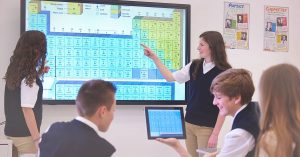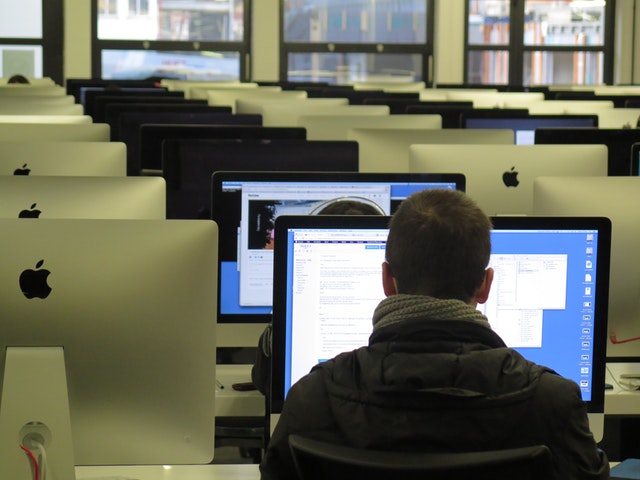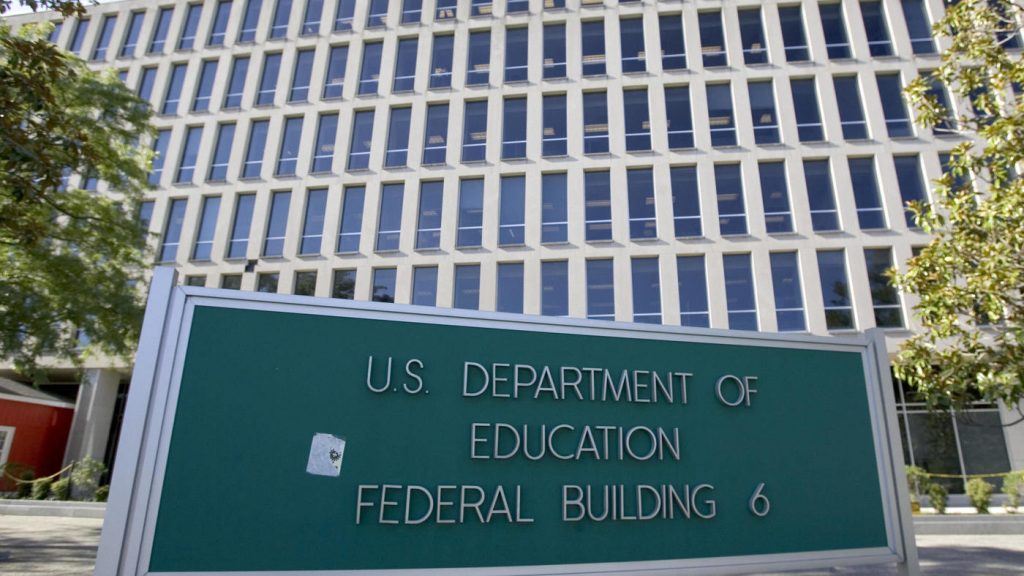
by The Solution Site | Nov 1, 2017 | Technology & Automation, The Discussion, The Solution Site
The 21st century’s world citizens hail global trends in educational systems, and educational courses around the computer. Parents, educators, administrators, and world leaders are all concerned about the worlds educational needs. Automation and technology are now, and will continue to be leading industries in the United States. With that knowledge, classes in both of these future trends should be a priority.
The world sees technology as part of a learning pedagogy because of its possible positive influences on effectiveness, student-centered learning, and time-management.
One might say that the roles have not been replaced, but improved upon if used correctly. That technology and computers are supposed to work together and improve not hinder my child’s:
- Engagement
- Motivation
- Independent Learning
- Engagement of parental units
- Focus on Staff and Student punctuality
- Extended learning times (2017)

Woman searching on oogleg
Personal interaction is still in a small way prevalent, yet these trends exist as a way to use this, not as a sole distributor of education but as a contributor. Either way, the use of technology has become part of many states’ educational and tested standards and has been added to the curriculum. Teachers in K-12 are supposed to use some form of technology as part of the daily class routine. Unless, of course, your child decides to go a different route and registers for online courses which are now even available to high school students.
Automation as a field of study is understood, but as a replacement for a human teacher, no matter how highly technologically advanced, is not something that can be educationally sound on any level and certainly not in K-12 grades. A flipped classroom has been tried in which a video of a teacher is watched as an alternative technological method, but education leaders argue that teachers will always be needed. Their presence is required to help comprehend issues and help understand the material and answer any questions about this material. The teacher can also become a tutor, facilitator, and spend more one-on-one time with students (2017).

A great example of which both education and technology used
The key to successful use of technology in education and not allowing total automation is the acknowledgment in the necessity of educators and the correct planning of the technological advancements and the role technology will play (USDOE, 2017). In 2017, The United States Department of Education published a National Update Reimagining the Role of Technology. The topics of inclusion are Learning – Engaging and Empowering Learning through Technology; Teaching- Teaching with Technology: Leadership- Creating a Culture and Condition; Assessment- Measuring for Learning; Infrastructure – Enabling Access and Effective Use. It is obvious that the Department of Education thinks that technology and understanding all its possibilities is important to the educational needs of our students.
It is this publication that reaffirms that important aspects of technology in education will always be necessary. It is an important tool, affirming relationships between teachers and students, adapting learning experiences for all students, and reinventing approaches to learning and working together. Every educator should be using technology and familiarizing him or herself with all possible technological advances in the educational world before the educator is left behind. Likewise, policymakers in the education fields need to prepare for the inevitable changes, and create courses and curriculums that teach how to maintain the software and instruments of the new technology and automation.
As early as middle school more STEM programs need to be made available, secondary schools need to have more in-trade school students, and code literate students in their vocational training.

Colleges need to become more affordable and grants and scholarships more accessible (Cook, 2015).
The answer to the whirlwind and upheaval of the new century of technological and automation breakthroughs for the world of education is to ‘gear up’ and make ready for generations of students who will be needing jobs, and the future is set for jobs in the fields of Science, Technology, Engineering, and Mathematics.
Middle schools, high schools, and colleges need to set their primary goals on creating courses fit for educating and meeting those needs. Only in this manner are we going to be able to bridge the unemployment gap and the low educational statistic gap.

by The Solution Site | Oct 11, 2017 | Global Trends, The Discussion, The Solution Site
Upon doing an internet search for Changes in Global Education Trends, it seemed everyone, in every field and every walk of life seemed to have an opinion and a blog about the subject, and with good reason as the area of Education Trends in the U.S. is a topic of conversation globally. In simple terms, the Education trends for the U.S. have always been:
- Testing & Assessment
- Sizes of classroom and schools
- Equality in Education
- School Funding
- Gender Recognition in Schools
- School Choice, Management
- Teacher Assessment and Quality
- Technology

Merging of technology and media
A newer trend arising is the merging of technology and media in all cultures across the world and this is something that is markedly altering the method by which we learn and discover around the globe and how we question the very fundamentals of education (CML, 2017).
Looking at what the Center for Media Literacy considers to be the world’s education trends and issues, we see a list of titles that includes topic areas such as:
 Empowerment through Education: The acknowledgment that higher education affords students a higher socioeconomic status as an adult and opens them to further possibilities post-secondary school; and expressing the importance of finishing high school (CML,2017).
Empowerment through Education: The acknowledgment that higher education affords students a higher socioeconomic status as an adult and opens them to further possibilities post-secondary school; and expressing the importance of finishing high school (CML,2017).
 How to Use Technology to Make You More Aware and Alive: Technology is one of the top fields of employment at present and in the future, and a higher education is needed to obtain a position in this field (Byrne, n/a).
How to Use Technology to Make You More Aware and Alive: Technology is one of the top fields of employment at present and in the future, and a higher education is needed to obtain a position in this field (Byrne, n/a).
 Learning with Technology: Proof that technology supports learning (Marshall, 2017).
Learning with Technology: Proof that technology supports learning (Marshall, 2017).
 What we Know about Young Children, TV and Media Violence: What experts have learned about the effects of TV on young children (CML, 2017).
What we Know about Young Children, TV and Media Violence: What experts have learned about the effects of TV on young children (CML, 2017).
As we more deeply explore the subject of global trends or Megatrends the future vision of educators is focused primarily on economic and employment demands and the individual’s priorities for the future. According to the British Council, while megatrends influence much of higher education, other critical trends will impact K-12 Education both presently and as anticipated in the years to come (Hughes, 2017).
Yet, another source agrees that education taught through technology will transform learning. “Technology created with education will transform how people are taught” (Hughes, 2017, p.12).
Hughes also brings up other agreed-upon international K-12 trends. For example:
- Specific Skills Employment: Many jobs will be replaced by technology, so that leaves employment with greater skills and higher degrees, like those in the STEM programs. Educational programs will have to be made available to students (2017, p.14).
- English as a Medium of Instruction (EMI): In the United States, ESOL (English as a Second Language) is taught as part of the curriculum as the U.S., as well as other countries, realizes that knowing the language is still a linguistic, economic, and pedagogical necessity (2017, p.16).
- Student-Centered Experiences, Environments, and Education: Schools and universities are discovering that students in educational environments that are student-centered and combined with creativity, innovation, design, and performance will have a more enriched and empowered education and are more likely to stay in K-12 and continue through school into post high school education (Patrick, 2015).
- Increasing Cross-Cultural Diversity: Identifying, recognizing, punishing, and banning situations of clear racism and discrimination, and creating a society where cultural diversity is accepted and taught (Parker, 2013).

US Department of Education Building
Understanding the trends that drive the forces behind the education field globally will help the American society comprehend what pushes the deciding factors of the decision-makers in the U.S. Department of Education. The U.S.DOE’s goals and mission of incorporating these trends is based on the knowledge that these trends will assist in the empowering of future generations of students, provide for the inclusion and support of families, support the longitudinal views and foundation of administrations at the school level, and accept the necessary and approved changes made by policy makers at a district level.

by The Solution Site | Sep 16, 2017 | K-12 Education, Reforms, The Solution Site
Two of America’s largest political and economic concerns are the educational system and the unemployment rate. Unfortunately, as time progresses they become more paradoxical. Three-quarters of the rapidly growing fields of occupations: science, engineering, technology, and mathematics, require students to have an education beyond high school. Unfortunately, the United States is also close to the top of the list regarding school dropout rates across the world. For those who do graduate and attend college, over half need remedial classes, and never manage to achieve graduation.
A college degree is a primary way to boost the U.S. economic growth and increase what we have been lacking more recently – a thriving and strong middle class. For that to happen, the education system has to improve immensely, and that means throughout preschool and into college, or careers, or the innovation-based economy that future generations will employ to make their livings.
For that challenge, in 2009, the Obama Administration launched a set of core reforms that he hoped would ensure that more students would take advantage of the free K-12 education they are receiving and encourage a better take-up of the college track post high school.
Core Reforms – Obama 2009
 Highly Regarded Preschools: $1 billion was invested to promote preschool attendance for all American children; over half the states markedly boosted their own investments in early learning. Through the Obama Administration’s Race to the Top – Early Learning Challenge Program, 5.2 million children from low-income families in 20 states will benefit from high-quality, seamless state-funded early learning systems that link education, health, nutrition, and family supports. Additionally, 18 states are building or enhancing their infrastructure to provide or expand high-quality preschool programs in high-need communities through Preschool Development Grants.
Highly Regarded Preschools: $1 billion was invested to promote preschool attendance for all American children; over half the states markedly boosted their own investments in early learning. Through the Obama Administration’s Race to the Top – Early Learning Challenge Program, 5.2 million children from low-income families in 20 states will benefit from high-quality, seamless state-funded early learning systems that link education, health, nutrition, and family supports. Additionally, 18 states are building or enhancing their infrastructure to provide or expand high-quality preschool programs in high-need communities through Preschool Development Grants.
 Higher Standards: More than 24 million students have access to higher standards of education than they did a few years ago
Higher Standards: More than 24 million students have access to higher standards of education than they did a few years ago
 Data and Assessments with more application: The reform invested $360 million in states that created a newer measurement aligned to career-ready and college- standards that exceed the outdated bubble tests, concentrating with a focus on problem-solving, critical thinking, and writing.
Data and Assessments with more application: The reform invested $360 million in states that created a newer measurement aligned to career-ready and college- standards that exceed the outdated bubble tests, concentrating with a focus on problem-solving, critical thinking, and writing.
 All classrooms having effective and dedicated educators: All students require and are worthy of strong and passionate teachers; however, research reveals that those of low-income and minority students are considered to have less innovative and dedicated teachers than other students.
All classrooms having effective and dedicated educators: All students require and are worthy of strong and passionate teachers; however, research reveals that those of low-income and minority students are considered to have less innovative and dedicated teachers than other students.
 Discipline and Civil rights: In 2014, the U.S. Departments of Education and Justice issued the package of guidance and resource materials the purpose of which was to aid schools’ focused attention on the excess of exclusionary punishment and unbalanced levels of correction for students with disabilities and students of color.
Discipline and Civil rights: In 2014, the U.S. Departments of Education and Justice issued the package of guidance and resource materials the purpose of which was to aid schools’ focused attention on the excess of exclusionary punishment and unbalanced levels of correction for students with disabilities and students of color.
(U.S. Department of Education, 2015)
Present Reforms And Of The Future

Barack Obama
These reforms introduced during the Obama Administration (2008-2016) set the standard for the creation of the following reforms and their futures, recommended or discussed in either the Obama or the current president’s Administration.
- Creating the STEM Program: This reform investigates methods of calculating classroom subject material and procedures in the Common Core State Standards for Mathematics and the Next Generation Science Standards to enhance and increase knowledge in the areas of technology, science, engineering, and math education.
- School Choice – Giving Parents the Knowledge They Need: Parents need information about the educational lessons, amenities, and the school climate to make informed decisions about schools. An advanced method of measuring and accumulating information on performance and an approach to making the method available to families is needed in the schools.
- The Improvement of Leadership in Schools: The Every Student Succeeds Act provides states and districts with fresh opportunities to provide for school leadership. Based on evidence, mediations, interventions, and more involvement from school policymakers it has been proven that the quality of school leadership can be vastly improved.
(RAND, 2017)

Students benefit from STEM program
These are a sampling of the latest initiatives added to the United States educational reforms.
However, the need for higher educated people has never been greater, especially in the areas that STEM covers. Parents, students, school leaders and the general populace can expect to see more reforms, more transitions, and constant changes until the United States is where it needs to be with regard to meeting the educational needs of its citizens.
The U.S. educational system has continued to slip and fall behind over the past five decades due to changing demographics and socioeconomics.















